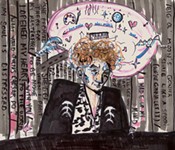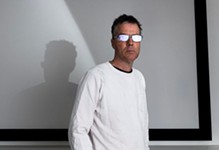Rock & Roll Books
Gift guide
By Shawn Badgley, Fri., Dec. 3, 2004

Chronicles: Volume One
by Bob DylanSimon & Schuster, 293 pp., $24
Studio A: The Bob Dylan Reader
edited by Benjamin HedinNorton, 336 pp., $24.95

You'll find Sam Shepard's 1987 one-act "A Short Life of Trouble" near the middle of Studio A: The Bob Dylan Reader, which, of the 30 or so such collections published over the past three decades, is the most varied and valuable. It's also the most potent, so much so that one almost overlooks the play amid the other 45 reprinted or previously unpublished contributions from the likes of Greil Marcus, Hendrik Hertzberg, Camille Paglia, Johnny Cash (the winking amicus brief to Broadside), Lester Bangs, Clive James, Joyce Carol Oates, Jonathan Lethem, Anne Waldman (the startling 1976 poem "Shaman Hisses You Slide Back Into the Night"), Barry Hannah, and Dylan himself.
But don't overlook Shepard's two-guys-talking-at-a-table, a blurred scene on Dylan's Malibu patio. The playwright is there as interviewer for Esquire. Dylan is relatively unguarded. Dylan is funny. Dylan strums a guitar. Cars crash on what's likely Highway 1, but he doesn't notice. They talk about James Dean, polka, Duluth, angels, dreams, Woody Guthrie, testicular cancer, Hank Williams, women, Bob Marley, the motorcycle accident. Mysteriously, when Shepard replays the interview tape during a break, nothing but Jimmy Yancey piano music comes out.
I hadn't read "A Short Life of Trouble," and by the time I had, it was about an hour after having finished Dylan's Chronicles, a book that in recent months has been discussed to an extent approaching Philip Roth's or Tatum O'Neal's, depending on the discussion. Excluding the motorcycle accident – which, and I think I speak for all of us here, warrants more than a sentence (or, damn you, Dylan, maybe not?) – Shepard's one-act reminds me a whole lot of reading Dylan's autobiography. At times, in fact, I thought I was.
In Chronicles – as much an epic historical prose poem as it is a mind-blowing, elliptical, picaresque memoir – Dylan is relatively unguarded. Dylan is funny. Dylan is street. Dylan is substantive. With an eye occasionally cataractous but most often clear, he describes friends and enemies, encounters and environments, insecurities and epiphanies. Len Chandler. Greenwich Village. Camilla Adams' party for a dying Cisco Houston. Jon Pankake. Harry Belafonte. Meeting the Duke on the set of In Harm's Way. Small-town Minnesota reflections. The bizarre midlife crisis that was recording Oh Mercy in New Orleans. Relearning the guitar based on an early Lonnie Johnson lesson. And his first love, Suze Rotolo, taking him to see a production of Brecht and Weill songs she was working on. Along with Guthrie and Robert Johnson, "Pirate Jenny" would make for nothing less than the origin of his own creation – the spark for his big bang – and he explains how.
So, as one might expect from a memoir, Dylan reveals more than a few things we would never find out elsewhere, which is notable mainly because he's Dylan, and has nurtured his own mystique – his privacy, really – like a bonsai. Beyond that, your own appreciation for his art will in turn effect how much you might appreciate his backstory. Still, like his best work, it possesses an undeniable universal pull. The guy, you might've heard, can tell a story, and he can tie it to, like, big things.

Dylan gets to NYC in 1961. He crashes on couches. This you found out. He remembers waking up after scavenged gigs, warm on the couch of Ray Gooch and Chloe Kiel during a blizzard – for weeks. This you maybe found out. This you did not find out: Kiel was a Southern belle with black nail polish who believed "Dracula ruled the world" and was "the son of Gutenberg." Gooch had guns, opium, and "blood in his eyes, the face of a man who could do no wrong." They had books. "The books were something. They were really something."
Dylan addresses Thaddeus Stevens' and Teddy Roosevelt's affect on his work. Dylan connects Prussian military mind Clausewitz and once wanting to attend West Point to wrestler Gorgeous George's maybe mouthing "You're making it come alive" when the singer was a teenager playing for free in the lobby of the National Guard Armory in Duluth. Back to Clausewitz and, finally, to the claim that "politics has taken the place of morality." Dylan writes things like "Dostoyevsky was accused of writing socialist propaganda. He was eventually pardoned and wrote stories to ward off his creditors. Just like in the early Seventies I wrote albums to ward off mine." Dylan notes at one point that "Balzac is hilarious."
None of this you found out. If you somehow did – if you were even on the right track as to what might possibly make him tick – it was only from the songs.
The songs are the Jimmy Yancey piano lines. They're all that matters. They're the tell-all, the big story. They're all that's coming out. Chronicles – along with the works of Shepard and 44 others in Studio A – is just good conversation, a bit of context. There are gaps, big ones (1964-66, anyone?), and typical fits of strategic reticence (relatively unguarded). So, then why did Dylan write it, and why has he promised more amid 150 tour dates a year? And, more to the point, why should we care?
Because, in my mind at least, after the interviewer in "A Short Life of Trouble" left for the evening, after the host pretended not to notice the car crashes, he could put down his guitar, go out his side door, walk down the road a ways, and examine the wreckage. He saw escapes, but he also saw a lot of pain. He saw a chase and a flip, a fireball going over a cliff. Maybe a motorcycle without a rider, or a rider without a motorcycle. A limo driver arguing over insurance with a cop. Shapes in the smoke that he was able to identify as he got closer – he rescued some and abandoned others.
And then he went back home and thought about it for a while. Laughed, cried, looked out the window, just like anyone else. Maybe he thought of "My Life in a Stolen Moment," the mythmaking prose-poem printed in the program of his April 12, 1963, Town Hall concert, which opens Studio A. "Somewheres back I took the time to start playin' the guitar," it reads. "Somewheres back I took time to start singin'. Somewheres back I took the time to start writin'. But I never did take the time to find out why."








